Related Research Articles
The history of Guyana begins about 35,000 years ago with the arrival of humans coming from Eurasia. These migrants became the Carib and Arawak tribes, who met Alonso de Ojeda's first expedition from Spain in 1499 at the Essequibo River. In the ensuing colonial era, Guyana's government was defined by the successive policies of the French, Dutch, and British settlers. During the colonial period, Guyana's economy was focused on plantation agriculture, which initially depended on slave labor. Guyana saw major slave rebellions in 1763 and 1823. Following the Slavery Abolition Act of 1833, 800,000 enslaved Africans in the Caribbean and South Africa were freed, resulting in plantations contracting indentured workers, mainly from India. Eventually, these Indians joined forces with Afro-Guyanese descendants of slaves to demand equal rights in government and society. After the Second World War, the British Empire pursued policy decolonization of its overseas territories, with independence granted to British Guiana on May 26, 1966. Following independence, Forbes Burnham rose to power, quickly becoming an authoritarian leader, pledging to bring socialism to Guyana. His power began to weaken following international attention brought to Guyana in wake of the Jonestown mass murder suicide in 1978.

Walter Anthony Rodney was a Guyanese historian, political activist and academic. His notable works include How Europe Underdeveloped Africa, first published in 1972. Rodney was assassinated in Georgetown, Guyana, in 1980.

Demerara is a historical region in the Guianas, on the north coast of South America, now part of the country of Guyana. It was a colony of the Dutch West India Company between 1745 and 1792 and a colony of the Dutch state from 1792 until 1815. It was merged with Essequibo in 1812 by the British who took control. It formally became a British colony in 1815 until Demerara-Essequibo was merged with Berbice to form the colony of British Guiana in 1831. In 1838, it became a county of British Guiana until 1958. In 1966, British Guiana gained independence as Guyana and in 1970 it became a republic as the Co-operative Republic of Guyana. It was located around the lower course of the Demerara River, and its main settlement was Georgetown.

Linden Forbes Sampson Burnham was a Guyanese politician and the leader of the Co-operative Republic of Guyana from 1964 until his death in 1985. He served as Premier of British Guiana from 1964 to 1966, Prime Minister of Guyana from 1964 to 1980 and then as the first Executive President of Guyana from 1980 to 1985. He is often regarded as a strongman who embraced his own version of socialism.
Eusi Kwayana, formerly Sydney King, is a Guyanese politician. A cabinet minister in the People's Progressive Party (PPP) government of 1953, he was detained by the British Army in 1954. Later he left the PPP to form ASCRIA, a Pan-Africanist grassroots political group that, after a brief flirtation with the People's National Congress (PNC) of Forbes Burnham, fused into the Working People's Alliance (WPA). Kwayana is also a playwright.
Rappu Falls is a waterfall on the Essequibo River, Guyana, approximately 17 km north of the confluence with the Rupununi River.
Peter "Lauchmonen" Kempadoo was a writer and broadcaster from Guyana. He also worked as a development worker in the Caribbean, Africa and Asia. He moved in 1953 to the UK, where he built a career in print journalism as well as radio and television broadcasting, and published two novels, Guiana Boy in 1960 — the first novel by a Guyanese of Indian descent — and Old Thom's Harvest in 1965, before returning to Guyana in 1970. He died in London, aged 92.
The National Library of Guyana is the legal deposit and copyright library for Guyana. Unlike many national libraries, it is also a public lending library and the headquarters of Guyana's public library service, with branches extending throughout the country. Founded in 1909, the National Library of Guyana is situated on the corner of Church Street and Main Street in central Georgetown. In 2007, the library recorded a collection of 397,893 books and a total of 22,058 members. Its collection includes the papers of A. J. Seymour and Ian McDonald.

Alfred Athiel Thorne, LLD, MA, also known as A.A.Thorne, was a well-regarded elected statesman, author, pioneer for educational access, and human rights advocate in British Guyana. In 1894, Dr. Thorne founded and oversaw a co-educational private secondary school, providing educational access to students regardless of their gender, ethnicity, color, or socio-economic status. Called the "Hero of The People", Thorne served as a popularly-elected official for more than 50 years, working to unify the collective voices of working-class white British colonists, Indo-Guyanese, Afro-Guyanese, Chinese, Portuguese, and Aboriginal Amerindian communities across British Guyana. He served multiple elected and appointed roles at both the national and municipal levels, including as Mayor of British Guiana's capital city, Georgetown. Thorne served many decades as an educator, columnist writer, and elected official in British Guiana, having a lasting impact for generations by advocating for educational access, workplace safety, human rights, democracy, and self-determination.

General elections were held in British Guiana on 15 October 1926.

General elections were held in British Guiana on 19 October 1921.

General elections were held in British Guiana in 1916.

General elections were held in British Guiana in 1911.

General elections were held in British Guiana in 1897.

James Rodway was a British-born historian, botanist and novelist of British Guiana. Considered British Guiana's premier historian, Rodway helped to establish national institutions such as the Royal Agricultural and Commercial Society of British Guiana and the British Guiana Museum. A Fellow of the Linnean Society, in later years he served as Editor of the colony's literary and scientific journal, Timehri.

Plantation Peter's Hall was a plantation on the east bank of the River Demerara in Dutch Guiana and British Guiana. It was probably laid out in the mid-eighteenth century and by the early nineteenth century had over 200 slaves before that institution was abolished in the British Empire.
Cummingsburg, or historically Cumingsburg, is a ward in Georgetown, Guyana. It began as 500-acre plantation, La Bourgade about 1759. When Thomas Cumming, a Scotsman, bought the property, he developed a town plan with residential and commercial lots and streets. The town layout was modified after a fire that burnt much of the town in 1864. Today, it is the site of several museums, including a national and anthropological museum.

Valerie Muriel Rodway was a Guyanese composer of cultural and patriotic songs, inspired by the events leading up to Guyana's independence in 1966. She is best known for composing music to accompany Guyana national poetry, like Arise, Guyana, Kanaïma, and the Martin Carter's Guyanese Independence poem Let Freedom Awaken. For the next two decades, school children were taught the songs she and others composed to inspire patriotism and cultural affinity. She selected the poetry for her compositions based upon her principles and values, first developed among her parents and siblings.
Egbert Martin, writing under the alias Leo, was a 19th-century Guyanese poet.
References
- 1 2 "Newspaper – National Archives of Guyana" . Retrieved 2020-12-29.
- ↑ Bayley, George D.; Permanent Exhibitions Committee of British Guiana (1909). Handbook of British Guiana, 1909. Comprising general and statistical information concerning the colony. The Library of Congress. [Georgetown] Printed by "the Argosy" company, limited; Boston, J.H. Stark; [etc., etc.]
- ↑ Rodney, Walter. (Ed. & Introduction) (1979) Guyanese Sugar Plantations in the Late Nineteenth Century: A Contemporary Description from the "Argosy". Georgetown: Release Publishers. p. x.
- ↑ The Argosy. British Library. Retrieved 26 February 2019.
- ↑ Boyd, Kelly. (Ed.) (1999). Encyclopedia of Historians and Historical Writing Vol. 2 M-Z. Chicago: Fitzroy Dearborn. pp. 1001–1002. ISBN 978-1-884964-33-6.